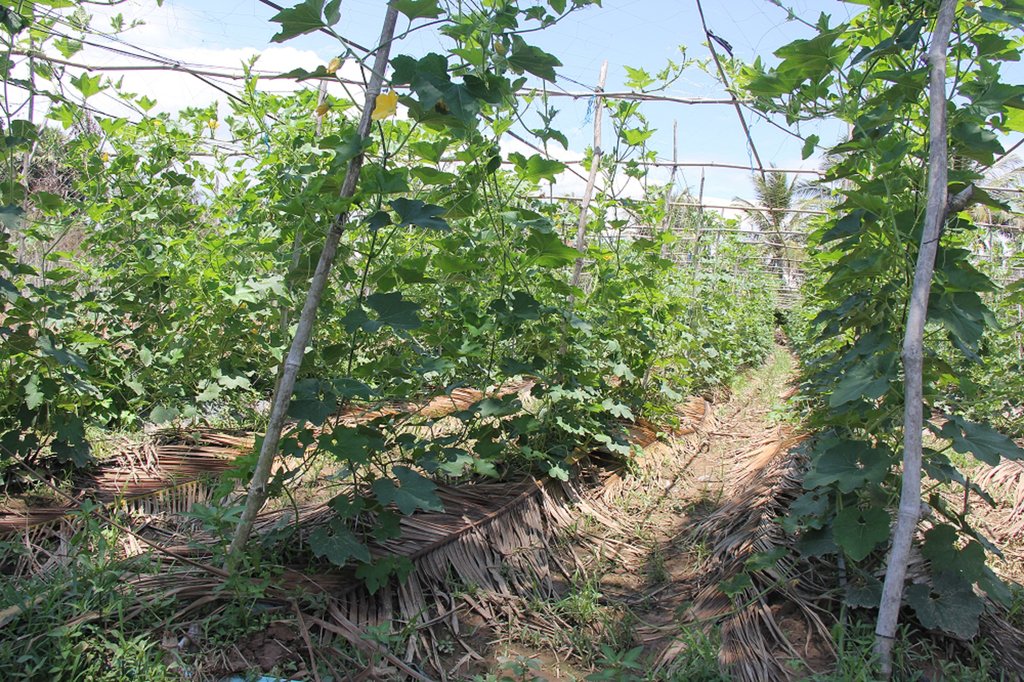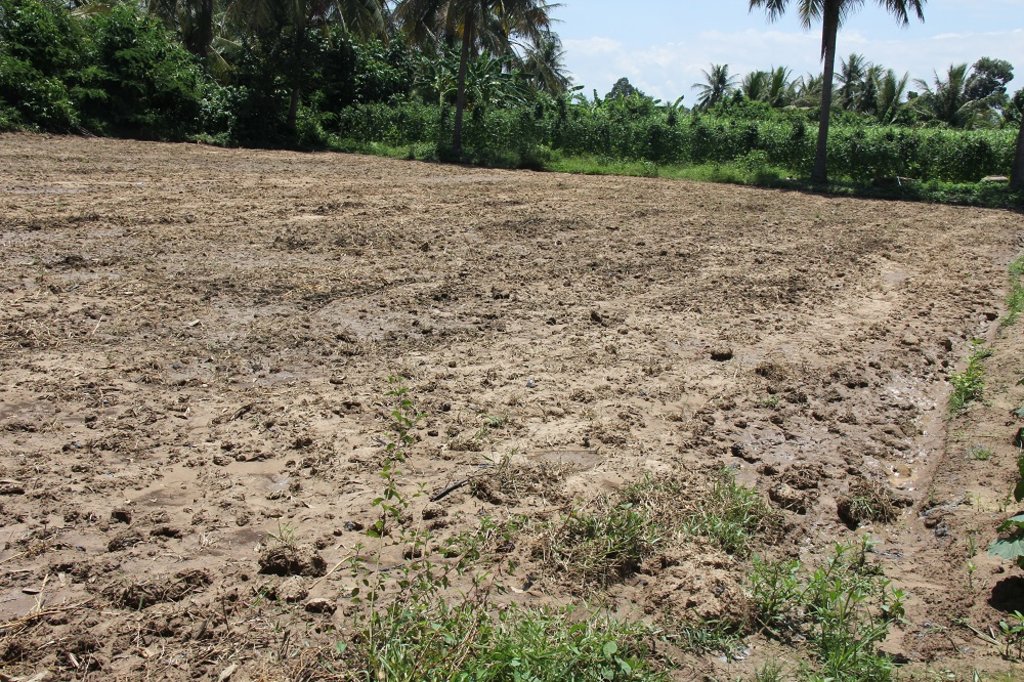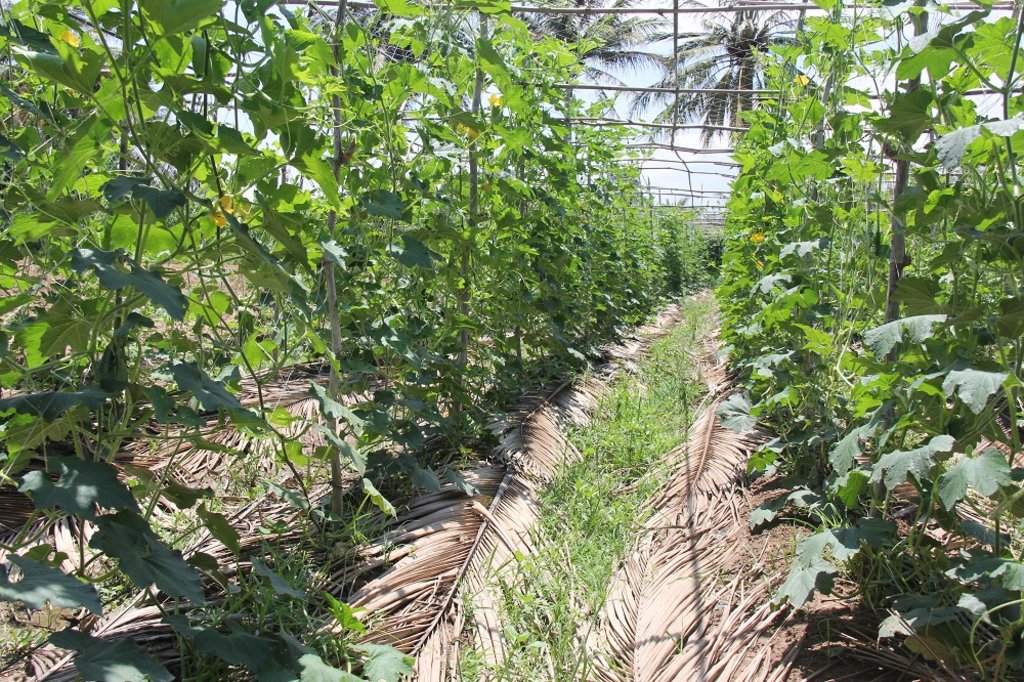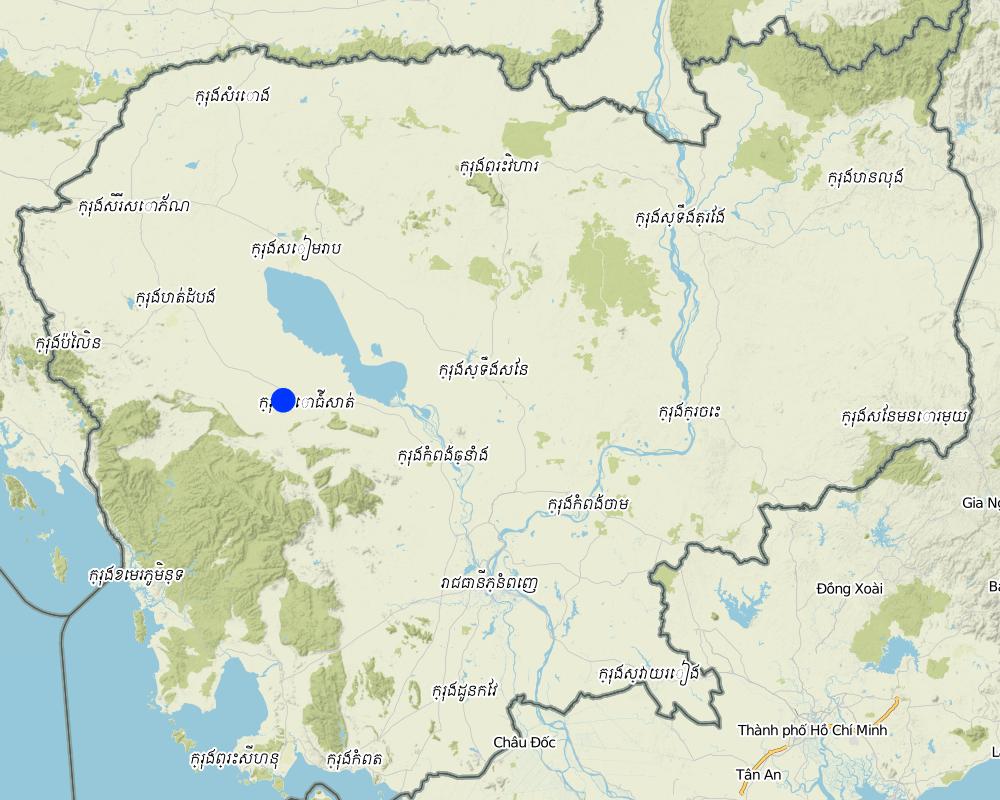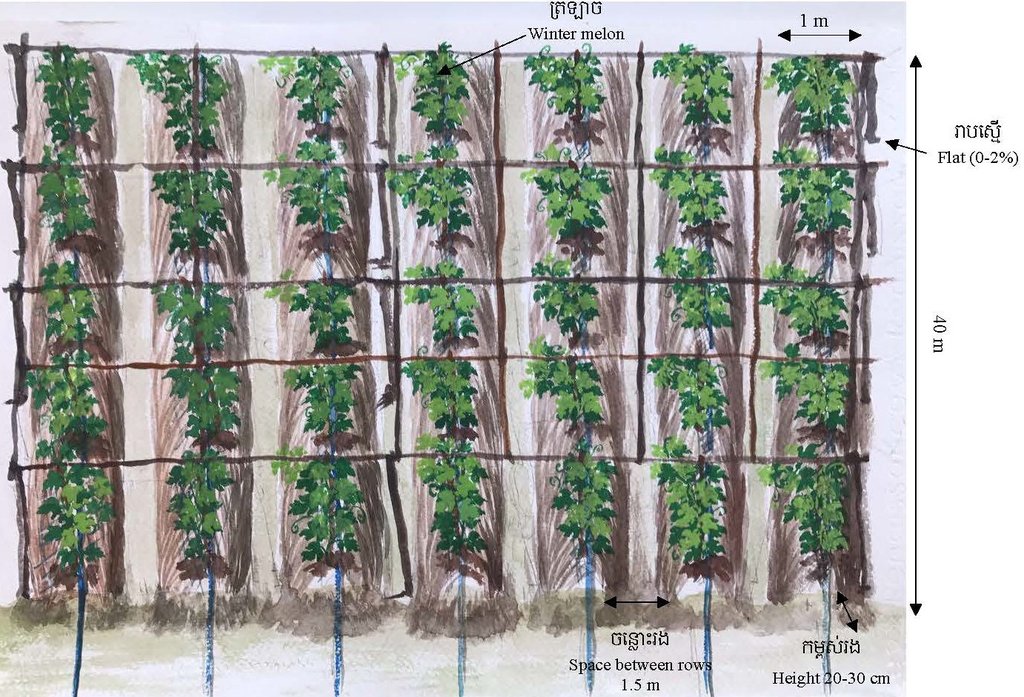Coconut leaves mulching for winter melon cultivation [Cambodia]
- Creation:
- Update:
- Compiler: Sok Pheak
- Editors: Sophea Tim, Navin Chea
- Reviewers: Nicole Harari, SO Than, Stephanie Jaquet, Ursula Gaemperli
technologies_3152 - Cambodia
View sections
Expand all Collapse all1. General information
1.2 Contact details of resource persons and institutions involved in the assessment and documentation of the Technology
Key resource person(s)
land user:
El Srey
(+855) 976555970
Farmer
Chamkar Ou village, Trapeang Chorng commune, Bakan district, Pursat Province
Cambodia
Chief of Agriculture Extension office:
Horn Sovann
(+855)16654386
Pursat Provincial Department of Agriculture, Forestry and Fisheries
Peal Nheaek Pir village, Phteah Prey, Pursat City, Pursat province
Cambodia
Chief of District Office of Agriculture, Forestry and Fisheries of Bakan:
Van Sokhun
(+855) 68836598
District Office of Agriculture, Forestry and Fisheries of Bakan
Kaoh Kaev village, Trapeang Chorng, Bakan district, Pursat province
Cambodia
Agronomic stafff:
Seng Kompheak
(+855) 964352665
District Office of Agriculture, Forestry and Fisheries of Kandieng
Kandieng village, Kandieng commune, Kandieng district, Pursat province
Cambodia
Name of project which facilitated the documentation/ evaluation of the Technology (if relevant)
Scaling-up SLM practices by smallholder farmers (IFAD)Name of the institution(s) which facilitated the documentation/ evaluation of the Technology (if relevant)
Royal University of Agriculture (RUA) - Cambodia1.3 Conditions regarding the use of data documented through WOCAT
When were the data compiled (in the field)?
27/06/2017
The compiler and key resource person(s) accept the conditions regarding the use of data documented through WOCAT:
Yes
1.4 Declaration on sustainability of the described Technology
Is the Technology described here problematic with regard to land degradation, so that it cannot be declared a sustainable land management technology?
No
2. Description of the SLM Technology
2.1 Short description of the Technology
Definition of the Technology:
The use of coconut leaves mulch for winter melon cultivation helps to conserve soil moisture, reduces evaporation, reduces weeds, saves water, preserves the soil from erosion, and increases crop productivity.
2.2 Detailed description of the Technology
Description:
Coconut leaves mulching is the process of covering the soil around plant root area using green/ dry coconut leaves to help keep the soil moisture longer and reduce evaporation and temperatures, especially during the dry season. Beside this, the use of coconut leaves mulch for covering rows of winter melons helps to prevent soil erosion, improves soil fertility, reduces weed growth, and increases soil fertility following the decomposition of the plant residues. The soils best suited to winter melon cultivation are loamy and sandy loam soils with a soil pH of between 5.0 and 6.3 and soils along the low-land areas. If the pH soil is lower than 5.0, the melon growth is not good and may accelerate the ripening of the fruit before the appropriate time, with the fruit plants sometimes dying due to lack of nutrients (TSTD, 2012). The roots of the winter melon are able to grow in soil with a depth of between 65 and 100 cm, particularly sandy soils. This crop is not suitable for cultivation in areas which are wind prone because of increased moisture loss through plant evapotranspiration. Such areas are also sometimes prone to high temperatures which are also unsuitable for winter melon.
The implementation area for this study was 280 squares meters, with a row height of 20-30 centimeters, a row width of 1 meter, row length of 40 meters, and row spacing of 1.5 meters. There were a total of 8 planted rows, with 40 melon stems being planted into each row. The crop stems and the intercrop space between the rows is covered with coconut leaves by laying the leaves along the slopes of the melon crop, with 5 or 6 coconut leaves as mulch along the two sides of the crop. In order to save time and water, farmers used drip irrigation using a pipe irrigation system that could provide water at a rate of about 6 liters per house, twice daily (in the morning and evening). Irrigation was provided over 20 minute periods at a rate of 100 ml per minute (although this was reduced during the rainy season). The watering technique is not required to fill the basal area of the stem of growing winter melon plants. Water is generally not provided at noon or late evening as watering at this time can cause problems, such as rotting of roots. If the soil around the stem becomes dry, more water should be applied at short notice without waiting for the soil to dry out. This is particularly important in the period immediately after planting of the seedlings, when water and nutrients are important for initial plant growth. Also, during the flowering and fruiting phases of melon plant growth, water needs have to be closely monitored. As the soil had previously been used for sugarcane cropping, the nutrient status of the soil was low, so farmers have improved the soil nutrient status by adding some organic fertilizer (cow manure) and some chemical fertilizers in an appropriate manner. In addition, some pesticides have been used as well.
In general, the advantage of this technique is the low cost materials which are locally available, such as coconut leaves, and materials which can be purchased in the local market, such as drip pipe, black plastic string, etc. However, the important aspects of the adoption of this technique, besides improving soil quality and maintaining a stable environment, is that it provides practical and potential economic benefits to farmers of about 800,000 (US$ 200) Riel per season.
2.3 Photos of the Technology
2.5 Country/ region/ locations where the Technology has been applied and which are covered by this assessment
Country:
Cambodia
Region/ State/ Province:
Chamkar Ou village, Trapeang chorng commune, Bakan district, Pursat province
Map
×2.6 Date of implementation
Indicate year of implementation:
2013
2.7 Introduction of the Technology
Specify how the Technology was introduced:
- through projects/ external interventions
Comments (type of project, etc.):
USAID Harvest project and Boosting Food Production
3. Classification of the SLM Technology
3.1 Main purpose(s) of the Technology
- improve production
- adapt to climate change/ extremes and its impacts
- create beneficial economic impact
3.2 Current land use type(s) where the Technology is applied

Cropland
- Annual cropping
Main crops (cash and food crops):
Winter melon
If land use has changed due to the implementation of the Technology, indicate land use before implementation of the Technology:
From 1992 to 2012 farmers were growing sugarcane
3.3 Further information about land use
Water supply for the land on which the Technology is applied:
- full irrigation
Number of growing seasons per year:
- 3
Specify:
The harvesting period from 2 to 2.5 months per time.
3.4 SLM group to which the Technology belongs
- improved ground/ vegetation cover
- ground water management
3.5 Spread of the Technology
Specify the spread of the Technology:
- evenly spread over an area
3.6 SLM measures comprising the Technology

agronomic measures
- A2: Organic matter/ soil fertility
3.7 Main types of land degradation addressed by the Technology

soil erosion by water
- Wt: loss of topsoil/ surface erosion

chemical soil deterioration
- Cn: fertility decline and reduced organic matter content (not caused by erosion)

biological degradation
- Bl: loss of soil life

water degradation
- Ha: aridification
3.8 Prevention, reduction, or restoration of land degradation
Specify the goal of the Technology with regard to land degradation:
- prevent land degradation
4. Technical specifications, implementation activities, inputs, and costs
4.1 Technical drawing of the Technology
4.2 Technical specifications/ explanations of technical drawing
The implementation area of this technology is 280 square meters. The technique used for the winter melon planting area was 1 meter in width and 40 meter in length with using pipe irrigation. The farmers used an interrow spacing of 1.5 m and there are 8 rows in total. The topography of the area is flat (0-2%) with the soil being a loamy and sandy soil. The establishment activities are working for the seedling preparation, the installment of the irrigation system, the building of the pole support, the seedling transplantation, the out planting of the winter melon seedlings including the cover by coconut leaves. Cow manure, rice husks and coconut coir were used as organic nutrient sources and improving the soil organic status for maintaining a stable environment.
4.3 General information regarding the calculation of inputs and costs
Specify how costs and inputs were calculated:
- per Technology area
Indicate size and area unit:
280 squre meters
If using a local area unit, indicate conversion factor to one hectare:
10000 square meters
other/ national currency (specify):
Riel
Indicate exchange rate from USD to local currency (if relevant): 1 USD =:
4000.0
Indicate average wage cost of hired labour per day:
25000 Riel
4.4 Establishment activities
| Activity | Type of measure | Timing | |
|---|---|---|---|
| 1. | Drying soil in the field | Agronomic | After harvest of crops |
| 2. | Create rows by hilling up soil | Agronomic | Before onset of rains |
| 3. | Installation of the irrigation system | Management | before outplanting of the winter melon |
| 4. | Digging the hole | Agronomic | 2 days before transplanting |
| 5. | Outplanting of the winter melon seedlings including the cover by coconut leaves | Agronomic | 1 day of outplanting |
| 6. | Building the pole of support | Structural | 3 days after transplanting |
| 7. | Seedling transplantation | Agronomic | Before onset of rains |
4.5 Costs and inputs needed for establishment
| Specify input | Unit | Quantity | Costs per Unit | Total costs per input | % of costs borne by land users | |
|---|---|---|---|---|---|---|
| Labour | Seedling preparation | person-day | 1.0 | 25000.0 | 25000.0 | 100.0 |
| Labour | Soil preparation | person-day | 5.0 | 30000.0 | 150000.0 | 100.0 |
| Labour | Building of the pole support | person-day | 2.0 | 25000.0 | 50000.0 | 100.0 |
| Labour | Installment of the irrigation system | pieces | 2.5 | 27500.0 | 68750.0 | 100.0 |
| Equipment | Hoe | set | 2.0 | 7000.0 | 14000.0 | 100.0 |
| Equipment | Scissors | set | 5.0 | 2500.0 | 12500.0 | 100.0 |
| Equipment | Hacksaw | set | 1.0 | 12000.0 | 12000.0 | 100.0 |
| Equipment | Axe | set | 1.0 | 12000.0 | 12000.0 | 100.0 |
| Equipment | Watering can | pair | 2.0 | 25000.0 | 50000.0 | 100.0 |
| Equipment | Floral hoe | set | 3.0 | 15000.0 | 45000.0 | 100.0 |
| Fertilizers and biocides | Pesticide | bottle | 2.0 | 2500.0 | 5000.0 | 100.0 |
| Fertilizers and biocides | DAP | bottle | 2.0 | 25000.0 | 50000.0 | 100.0 |
| Fertilizers and biocides | Cali | kg | 50.0 | 2400.0 | 120000.0 | 100.0 |
| Fertilizers and biocides | UREA | kg | 50.0 | 1800.0 | 90000.0 | 100.0 |
| Fertilizers and biocides | Cow manure | bag | 1.0 | 25000.0 | 25000.0 | 100.0 |
| Construction material | Black string for building pole support | kg | 5.0 | 47000.0 | 235000.0 | 100.0 |
| Construction material | Irrigation pipes | pieces | 2.5 | 90000.0 | 225000.0 | 100.0 |
| Construction material | Valve | number | 1.0 | 20000.0 | 20000.0 | 100.0 |
| Other | Create rows by hilling up soil | person-day | 2.0 | 25000.0 | 50000.0 | 100.0 |
| Total costs for establishment of the Technology | 1259250.0 | |||||
4.6 Maintenance/ recurrent activities
| Activity | Type of measure | Timing/ frequency | |
|---|---|---|---|
| 1. | Watering in the morning and evening | Management | 2 times per day, 2-3 minutes per time |
| 2. | Cutting the grass or branches of plant (3-4 braches) | Management | every 14 days per time during the growing period |
| 3. | Spraying the pesticide if needed | Management | when damaged by insects |
| 4. | Fixing the irrigaton pipes | Management | once per growing season |
| 5. | Installing poles support for the melon | Structural | once per growing season |
4.7 Costs and inputs needed for maintenance/ recurrent activities (per year)
| Specify input | Unit | Quantity | Costs per Unit | Total costs per input | % of costs borne by land users | |
|---|---|---|---|---|---|---|
| Labour | Thinning the branches | Person-day | 1.0 | 25000.0 | 25000.0 | 100.0 |
| Labour | Fixing the irrigation pipes | Person-day | 1.0 | 20000.0 | 20000.0 | 100.0 |
| Equipment | Irrigation pipes | kg | 8.0 | 4700.0 | 37600.0 | 100.0 |
| Equipment | Black strings for pole support | kg | 7.0 | 4700.0 | 32900.0 | 100.0 |
| Total costs for maintenance of the Technology | 115500.0 | |||||
4.8 Most important factors affecting the costs
Describe the most determinate factors affecting the costs:
• Fixing the irrigation pipes is 20000 Riel for repair service per time.
• Buying the black string for building pole support, which is 37600 Riel per time.
5. Natural and human environment
5.1 Climate
Annual rainfall
- < 250 mm
- 251-500 mm
- 501-750 mm
- 751-1,000 mm
- 1,001-1,500 mm
- 1,501-2,000 mm
- 2,001-3,000 mm
- 3,001-4,000 mm
- > 4,000 mm
Specifications/ comments on rainfall:
In 2015, the annual rainfall was 1225.7
In 2014, the annual rainfall was 1128.1
In 2013, the annual rainfall was 1316
Indicate the name of the reference meteorological station considered:
Ministry of Water Resources and Meteorology (2015)
Agro-climatic zone
- sub-humid
5.2 Topography
Slopes on average:
- flat (0-2%)
- gentle (3-5%)
- moderate (6-10%)
- rolling (11-15%)
- hilly (16-30%)
- steep (31-60%)
- very steep (>60%)
Landforms:
- plateau/plains
- ridges
- mountain slopes
- hill slopes
- footslopes
- valley floors
Altitudinal zone:
- 0-100 m a.s.l.
- 101-500 m a.s.l.
- 501-1,000 m a.s.l.
- 1,001-1,500 m a.s.l.
- 1,501-2,000 m a.s.l.
- 2,001-2,500 m a.s.l.
- 2,501-3,000 m a.s.l.
- 3,001-4,000 m a.s.l.
- > 4,000 m a.s.l.
Indicate if the Technology is specifically applied in:
- not relevant
5.3 Soils
Soil depth on average:
- very shallow (0-20 cm)
- shallow (21-50 cm)
- moderately deep (51-80 cm)
- deep (81-120 cm)
- very deep (> 120 cm)
Soil texture (topsoil):
- fine/ heavy (clay)
Soil texture (> 20 cm below surface):
- medium (loamy, silty)
Topsoil organic matter:
- high (>3%)
5.4 Water availability and quality
Ground water table:
< 5 m
Availability of surface water:
good
Water quality (untreated):
for agricultural use only (irrigation)
Is water salinity a problem?
No
Is flooding of the area occurring?
No
5.5 Biodiversity
Species diversity:
- medium
Habitat diversity:
- medium
5.6 Characteristics of land users applying the Technology
Sedentary or nomadic:
- Sedentary
Market orientation of production system:
- commercial/ market
Off-farm income:
- 10-50% of all income
Relative level of wealth:
- average
Individuals or groups:
- individual/ household
Level of mechanization:
- mechanized/ motorized
Gender:
- women
Age of land users:
- middle-aged
5.7 Average area of land owned or leased by land users applying the Technology
- < 0.5 ha
- 0.5-1 ha
- 1-2 ha
- 2-5 ha
- 5-15 ha
- 15-50 ha
- 50-100 ha
- 100-500 ha
- 500-1,000 ha
- 1,000-10,000 ha
- > 10,000 ha
Is this considered small-, medium- or large-scale (referring to local context)?
- small-scale
5.8 Land ownership, land use rights, and water use rights
Land ownership:
- individual, titled
Land use rights:
- individual
Water use rights:
- communal (organized)
- individual
5.9 Access to services and infrastructure
health:
- poor
- moderate
- good
education:
- poor
- moderate
- good
technical assistance:
- poor
- moderate
- good
employment (e.g. off-farm):
- poor
- moderate
- good
markets:
- poor
- moderate
- good
energy:
- poor
- moderate
- good
roads and transport:
- poor
- moderate
- good
drinking water and sanitation:
- poor
- moderate
- good
financial services:
- poor
- moderate
- good
6. Impacts and concluding statements
6.1 On-site impacts the Technology has shown
Socio-economic impacts
Production
crop production
Comments/ specify:
The farmer used the coconut leaves mulch keeps good soil moisture and increase soil nutrient, thus increasing the crop production.
Income and costs
expenses on agricultural inputs
Comments/ specify:
Farmer used raw material (coconut leaves) around her home that does not require any cost.
farm income
Comments/ specify:
This technology improves soil moisture and soil nutrient, with less expense on the inputs as the coconut leaves are available around the house, thus the farm income increases.
workload
Comments/ specify:
The farmer used irrigation pipe for watering the winter melon during the dry season, so it reduced her workload.
Socio-cultural impacts
food security/ self-sufficiency
Comments/ specify:
After the farmer applied this technology, she was able to better secure food consumption in her house, and as well she was able to sell the winter melons at the market to get more income for buying food.
health situation
Comments/ specify:
The farmer grew winter melon without any chemical use. She ate healthy vegetable that improved the health situation accordingly.
SLM/ land degradation knowledge
Comments/ specify:
Farmer knows how to conserve soil moisture and preserves the soil from erosion, and increases crop productivity through implementing this SLM technology as before her land was not good for planting vegetable. She tried to convert her land from infertile to fertile soil using animal manure (cow dung) mixed with topsoil from the hill.
Ecological impacts
Water cycle/ runoff
evaporation
Comments/ specify:
The technology area decreased the evaporation by using the coconut mulch as it keeps the soil moisture during the dry period.
Soil
soil moisture
Comments/ specify:
The soil moisture is still remain even it dried for 3 days.
soil organic matter/ below ground C
Comments/ specify:
The conversion from infertile to fertile soil using animal manure mixed with topsoil increased the amount of soil organic matter.
Biodiversity: vegetation, animals
beneficial species
Comments/ specify:
Earthworm is one of species to be found in the soil of technology area.
Climate and disaster risk reduction
drought impacts
Comments/ specify:
The improved soil moisture let the winter melon plant survive even at drought events of one week.
6.3 Exposure and sensitivity of the Technology to gradual climate change and climate-related extremes/ disasters (as perceived by land users)
Gradual climate change
Gradual climate change
| Season | Type of climatic change/ extreme | How does the Technology cope with it? | |
|---|---|---|---|
| annual temperature | increase | moderately | |
| seasonal temperature | summer | increase | moderately |
| annual rainfall | increase | moderately |
Climate-related extremes (disasters)
Meteorological disasters
| How does the Technology cope with it? | |
|---|---|
| local rainstorm | moderately |
Hydrological disasters
| How does the Technology cope with it? | |
|---|---|
| flash flood | moderately |
6.4 Cost-benefit analysis
How do the benefits compare with the establishment costs (from land users’ perspective)?
Short-term returns:
positive
Long-term returns:
positive
How do the benefits compare with the maintenance/ recurrent costs (from land users' perspective)?
Short-term returns:
positive
Long-term returns:
positive
6.5 Adoption of the Technology
- 10-50%
If available, quantify (no. of households and/ or area covered):
16 housholds of Chamkar Ou village implemented the technology (the one examined in this case study included)
Of all those who have adopted the Technology, how many have did so spontaneously, i.e. without receiving any material incentives/ payments?
- 10-50%
Comments:
8 households of all those have adopted the technology without receiving any material incentives/materials. However, the other households got supports from the USAID Harvest project include the cropping techniques and fertilizer application. The project of Boosting Food Production is providing the training on food safety for market demand.
6.6 Adaptation
Has the Technology been modified recently to adapt to changing conditions?
No
6.7 Strengths/ advantages/ opportunities of the Technology
| Strengths/ advantages/ opportunities in the land user’s view |
|---|
| This form of mulching is good for some farmers who do not have money for the purchase of plastic mulching materials. |
| It provides good soil health and keeps a stable environment for humans. |
| Strengths/ advantages/ opportunities in the compiler’s or other key resource person’s view |
|---|
| It is important that the farmers can understand the environment, and that they can also find low cost materials around their houses, such as coconut leaves mulch, because such materials will not pollute the soil and environment. |
| Keep the soil quality using animal manure (cow dung) |
6.8 Weaknesses/ disadvantages/ risks of the Technology and ways of overcoming them
| Weaknesses/ disadvantages/ risks in the land user’s view | How can they be overcome? |
|---|---|
| It is difficult for first time implementation. | Try as much as possible to learn from the growing experience. |
7. References and links
7.1 Methods/ sources of information
- field visits, field surveys
1 person
- interviews with land users
2 persons
- interviews with SLM specialists/ experts
3 persons
7.2 References to available publications
Title, author, year, ISBN:
Lalljee, B., 2013. Mulching as a mitigation agricultural technology against land degradation in the wake of climate change. International Soil and Water Conservation Research, 1(3), pp. 68-74.
Available from where? Costs?
Free of charge
7.3 Links to relevant information which is available online
Title/ description:
Agricultural Technique Manual of Tonle Sap Poverty Reduction and Smallholder Development Project
URL:
http://www.tssdcambodia.org/
Links and modules
Expand all Collapse allLinks
No links
Modules
No modules



